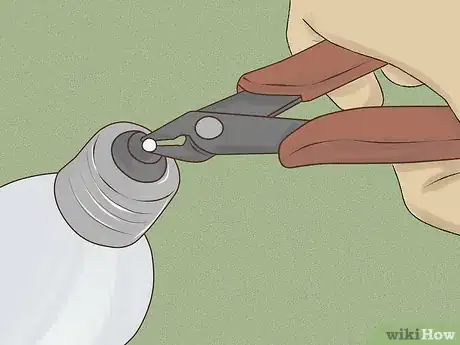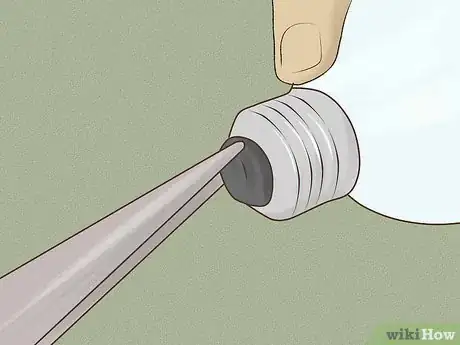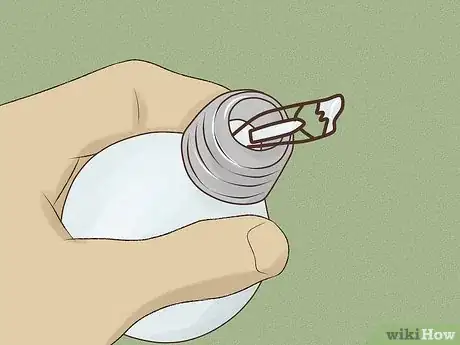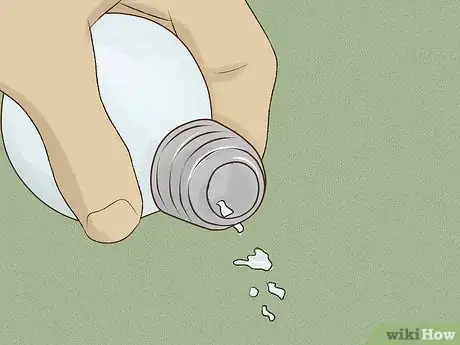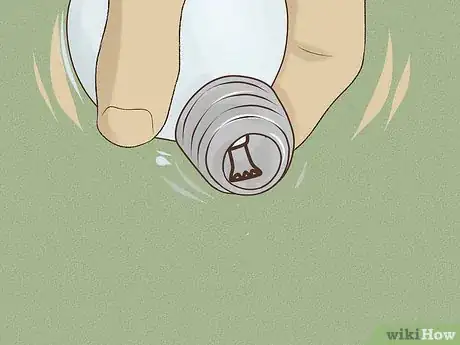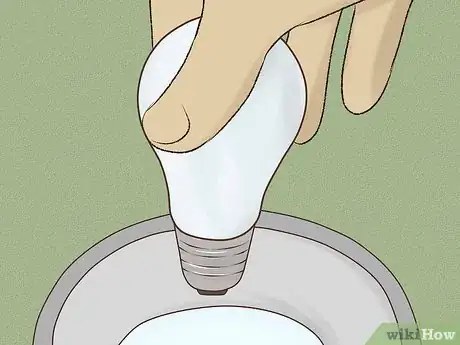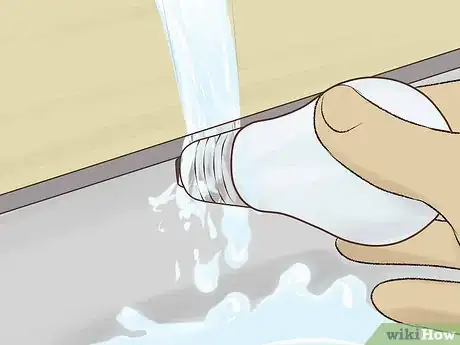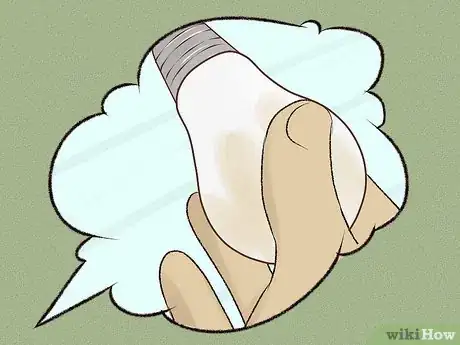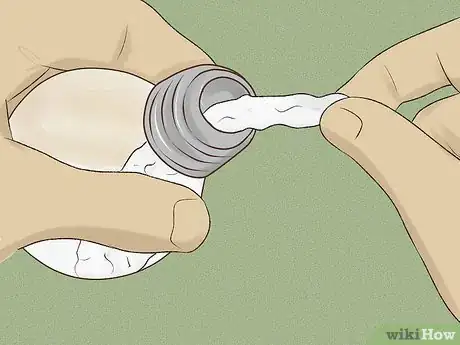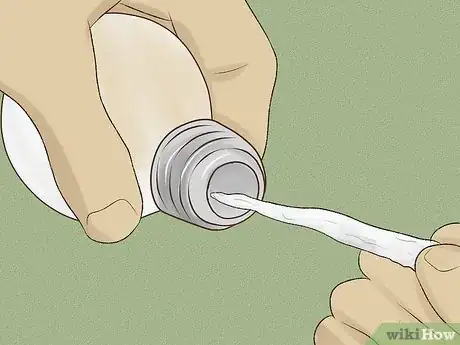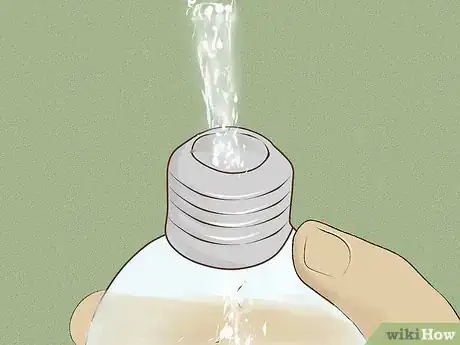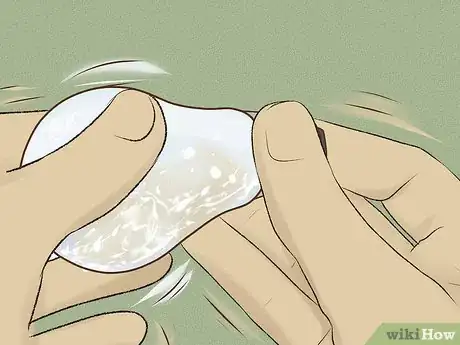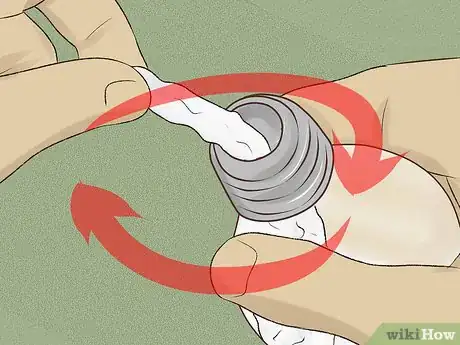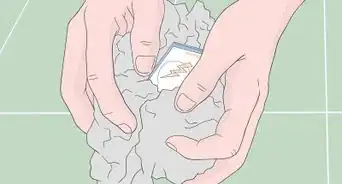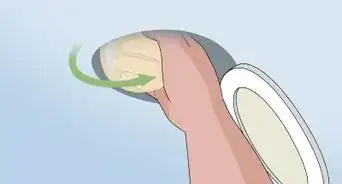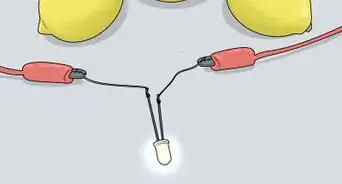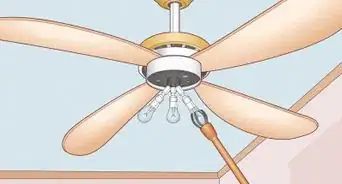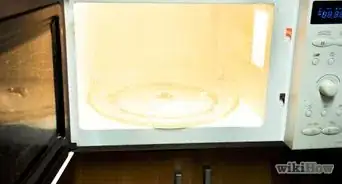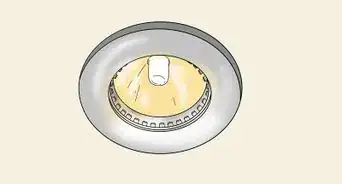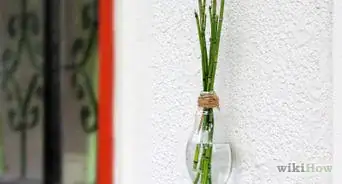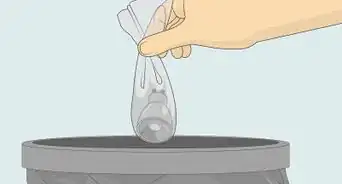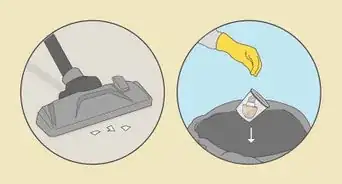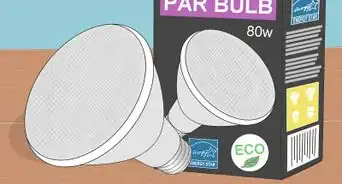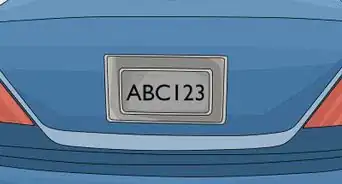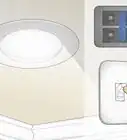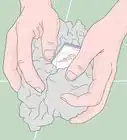wikiHow is a “wiki,” similar to Wikipedia, which means that many of our articles are co-written by multiple authors. To create this article, volunteer authors worked to edit and improve it over time.
This article has been viewed 196,930 times.
Learn more...
Empty incandescent light bulbs can be reused for numerous crafts, decorations, and science projects. Opening a light bulb can be a little tricky the first time, but the task is very doable once you know what to expect and how to manage it.
Steps
Opening the Light Bulb
-
1Grip the solder point with pliers. Look at the bottom of the light bulb and identify the small metal solder point. Grab this point firmly using a pair of needle-nose pliers.
- You'll be breaking glass during this step and during many of the other steps in this process, so it might be best to work over a box or several sheets of newspaper. You should also wear goggles and gloves.
-
2Twist and yank out the metal. Twist the solder point with your pliers until you feel the interior brass break one or more wires connected to the filament. Once the solder point is free, lift it out.
- Keep a firm grasp on the light bulb with your other hand while lifting out the solder point.
- You may need to nudge the sides of the solder point back and forth if twisting it does not prove effective.
- The sides of the metal should be raised enough for you to get a good grip on the tip with your pliers before you lift that point out.
Advertisement -
3Crack the glass insulator. Hold one side of the black glass insulator at the bottom of the bulb with your pliers. Twist it up to snap the glass apart.
- The glass here is thick, so it will take a lot of force to actually break it. Make sure that you hold onto the bulb firmly with your other hand as you work.
- The insulator will break into many chips when you do this, so proceed with caution.
- You may need to break the insulator from several angles around its perimeter if the entire thing does not break off the first time.
-
4Remove all broken bits of insulator. Use tweezers to clean away any black insulator glass from the socket of the bulb.
- These pieces of glass will probably be very sharp, so you should not touch them with your bare hands.
- After clearing away the insulator glass, you should be able to see the inner components of the light bulb from the bottom of the bulb.
-
5Snap away the interior fill tube. Insert a flathead screwdriver into the bottom of the light bulb, next to one side of the interior tube. Press the screwdriver against the side of the tube to break it free.
- The bulb will be filled with argon, or a similarly inert and harmless gas. When you break the tube free, you'll hear a noise that will signify the release of the argon gas.
-
6Remove the tube. Slide the screwdriver around the sides of the tube to break it completely free, then lift it out with tweezers or pliers.
- If you successfully manage to break the tube free without breaking the tube itself, you can reuse it for another project.
- If you cannot break the tube free from the sides, though, you may need to twist the screwdriver around more forcefully, breaking the tube itself in the process. Remove the broken shards with tweezers when done.
- You'll need to use considerable force, so make sure that your other hand has a firm grasp on the light bulb as you work.
-
7Remove the tungsten wire. Gently shake the rest of the filament assembly out of the bulb and onto your work surface.
- If the wire is still whole and intact, you can reuse this, as well.
- Note that you may need to remove the wire with pliers or tweezers, though.
-
8Break and remove any final bits of glass. If there are any small bits of glass remaining around the interior edge of the bulb, carefully break them off with the screwdriver.
- Lift the broken bits of glass away with tweezers.
- At this point, the light bulb is open and empty. You may even be able to stop here, but continue reading to determine whether or not that is the case.
Removing the Metal Socket
-
1Ask yourself if this is necessary. For most projects, you can keep the metal socket piece intact. If you only want the actual glass bulb for your project, however, you will need to remove the socket piece before continuing.
- You may want to remove this piece for visual aesthetics. Another reason to remove it would be to create as large an opening at the base of the bulb as possible.
- If you want to reattach the metal socket after removing it, you can do so by simply applying a little glue to the top edge and pressing it back onto the bottom of the glass bulb.
-
2Soak the socket in Muriatic acid. Place a shallow amount of Muriatic acid in a glass bowl. Rest the attached socket in this acid and let it soak for 24 hours.[1]
- Muriatic acid is a powerful cleansing agent often used for cleaning toilet bowls and other heavily stained plumbing surfaces.
- Only use enough acid to submerge the metal part of the bulb.
-
3Clean off the acid. After soaking the socket, remove it from the acid and rinse it well under running water.
- Use a little soap or a mild base, like baking soda, to neutralize the acid still clinging to the surface of the bulb socket.
- Wear gloves while working to protect your fingers from the harsh chemical.
-
4Carefully twist off the metal socket. Hold the bulb firmly with one hand, then slowly twist the socket off the bottom with your other hand.
- The acid should have dissolved the powerful adhesive glue holding the metal socket to the glass, making the socket loose and fairly easy to remove.
- If done carefully, you should be able to avoid breaking any glass at the bottom of the bulb.
Cleaning the Open Bulb
-
1Determine if this is necessary. If you started with a clear bulb, you don't need to clean it out. If you used a bulb coated with white kaolin powder, however, you'll want to clean this powder out before using the bulb for anything.[2]
- Kaolin is considered a safe substance, but you should still avoid ingesting it or getting it in your eyes. Keep your goggles and gloves on.
-
2Insert paper towels into the bulb. Stuff enough paper towel into the bulb to fill most of it, leaving a long enough "tail" sticking out from the bottom for you to grab.
- Watch out for any sharp edges or sharp bits of broken glass.
-
3Scrub away any powder. Using the tail of the paper towel, twist it around the interior of the bulb, wiping away the powder in the process.
- Dry paper towel will usually work well enough, but if you have difficulty cleaning the bulb with dry paper towels, consider moistening the towel slightly and trying again.
-
4Fill the bulb with salt. If some of the kaolin will not come out, fill the bulb one-quarter to half full with salt.
- You'll use the abrasiveness of the salt to help scrub the corners and angles of the bulb.
-
5Shake the bulb. Carefully cover the bottom of the bulb and give the entire thing a good shake. The salt should scrub away most of the remaining traces of kaolin.
- Place your gloved thumb over the bottom of the bulb to prevent salt from flying everywhere. You could also hold a paper towel over the bottom to accomplish the same goal.
- Dump out the salt when done. Dispose of this salt; do not reuse it.
-
6Switch back to the paper towels. If there is any salt or kaolin inside the bulb, use your paper towels to clean it out.
- The material inside the bulb should be loose enough at this point for the paper towel to catch.
- Once you are finished with this step, the bulb is completely open, clean, and ready to use for whatever project you have in mind.
Community Q&A
-
QuestionI have some mini light bulbs and I want to open those. How do I do that?
 Community AnswerTry choosing smaller tools to suit the job. Other than that, you can continue with the same instructions.
Community AnswerTry choosing smaller tools to suit the job. Other than that, you can continue with the same instructions. -
QuestionCan I remove the metal part of a light bulb without muriatic acid?
 Community AnswerIt depends on the light bulb. I don't know which you can and which you can't by looking at them, but the last time I took the metal part off of a light bulb I used grippers, squeezed around the base of the metal part all around, and I was able to pull the metal part off that way.
Community AnswerIt depends on the light bulb. I don't know which you can and which you can't by looking at them, but the last time I took the metal part off of a light bulb I used grippers, squeezed around the base of the metal part all around, and I was able to pull the metal part off that way. -
QuestionHow can we do it without pliers?
 Community AnswerIt's not possible to open a light bulb without pliers due to the risk of the whole thing shattering open.
Community AnswerIt's not possible to open a light bulb without pliers due to the risk of the whole thing shattering open.
Warnings
- Protect your eyes and hands as you work. Always wear safety goggles or glasses, and protect your hands with thick gloves.⧼thumbs_response⧽
- Never attempt to open a fluorescent light bulb. Compact fluorescent lamps (CFLs) contain mercury. This mercury is safe when contained inside the bulb, but it can pose a mild to moderate threat once the bulb is opened.[4]⧼thumbs_response⧽
Things You'll Need
- Incandescent light bulb
- Needle-nose pliers
- Scissors or snips
- Long tweezers
- Flathead screwdriver
- Safety goggles
- Gloves (rubber, plastic, or cloth garden gloves)
- Soap and/or baking soda
- Water
- Paper towels
- Salt
- Newspaper or box
- Muriatic acid (optional)
References
About This Article
To open a light bulb, twist out the metal solder point on the bottom of the bulb with a pair of pliers. Hold one side of the black glass insulator with your pliers, then twist it up to break the glass apart. Remove the broken bits of insulator glass and break off the interior tube with a flathead screwdriver. Gently shake out the rest of the filaments inside the bulb and remove any final bits of glass. To learn more about how to open a light bulb, including how to stay safe with protective equipment, keep reading.
